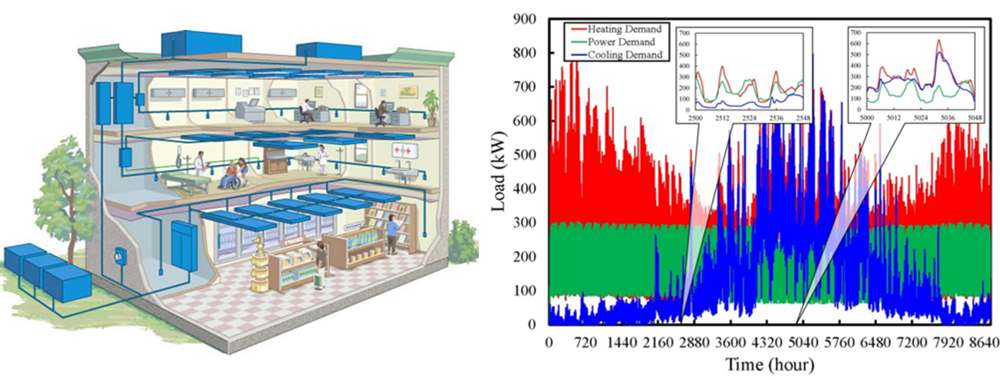High-Temperature Fuel Cells for Mobile and Stationary Applications
Design and Integration of Efficient Energy Systems For Low And Zero-Energy Commercial Buildings and Complexes With Cyber-Physical Systems
Cyber-Enabled Efficient Energy Management of Structures (CEEMS) concerns the sensing and control of energy flow in buildings, as enabled by cyber infrastructure. Energy is used for many activities in structures, including lighting, heating, cooling, and powering equipment. Coming changes in the way we generate and distribute electric energy will complicate the control of energy usage in buildings, yet hold great promise to enable significant improvements in energy efficiency. These changes include the development of local sources of energy production (solar, fuel cells, or gas turbines), energy storage (hydrogen production, active thermal storage, or hybrid cars in parking lots), and grid interconnections (smart meters and smart grids). This work brings together and interdisciplinary group of researchers to tackle the modeling, simulation, optimization and control aspects of CEEMS. Specifically, the project considers 1) simulation of buildings with multiple energy systems, 2) methods for the design and specification of advanced energy systems for buildings, 3) supervisory control of energy generation and storage, 4) methods for modeling of human networks, and 5) model reduction/identification of network structured models, and 6) decision and control for networks of heterogenous dynamic systems.
Researchers in the Departments of Electrical Engineering Computer Science and Mechanical Engineering collaborated on this project from 2009-2012. AESG researchers focused on cost optimal design dispatch of fuel cell-based combined heat and power systems for commercial buildings. Large, mixed-integer nonlinear programs were employed to find cost optimal sizing and dispatch solutions. Detailed system-level dynamic modeling simulation of 25 kW SOFC systems were also performed to make an engineering assessment of load-following strategies recommended by MINLP optimal operating strategies.
FUNDING: NSF

PUBLICATIONS
- K. Pruitt, A. Newman, S. Leyffer, R.J. Braun, A Mixed-Integer Nonlinear Program for the Optimal Design and Dispatch Of Distributed Generation Systems, Optimization and Engineering, 15(1):167–197, (2014).
- K. Pruitt, R.J. Braun, A. Newman, Evaluating Shortfalls In Mixed-Integer Programming Approaches for the Optimal Design and Dispatch Of Distributed Generation Systems, Applied Energy, 102:386–398, (2013).
- K. Pruitt, R.J. Braun, A. Newman, Establishing Conditions For The Economic Viability Of Fuel Cell-Based, Combined Heat And Power Distributed Generation Systems, Applied Energy, 111:904–920, (2013).
Current Projects
Past Projects
Selected Publications in This Research Area
Design of Protonic Ceramic Fuel Cell Systems and Their Potential as a Distributed Power Generator with Electric Efficiencies Exceeding 70% (working paper)
A. Dubois, K. Ferguson, R.J. Braun
Journal of Power Sources, (2020)
Development of kW-Scale Protonic Ceramic Fuel Cells and Systems
R.J. Braun, A. Dubois, K. Ferguson, C. Duan, C. Karakaya, R.J. Kee, … A. Wood
ECS Transactions, 91(1):997–1008, (2019)
Steady-State and Dynamic Modeling of Intermediate-Temperature Protonic Ceramic Fuel Cells
K.J. Albrecht, A. Dubois, K. Ferguson, C. Duan, R.P. O’Hayre, R.J. Braun
Journal of The Electrochemical Society, 166(10):F687–F700, (2019)
R.J. Braun, E. Reznicek, C. Cadigan, N.P. Sullivan, R. Danforth, T. Bandhauer, S. Garland, D. Olsen, B. Windom, B. Schaffer
ECS Transactions, 91(1):355–360, (2019)
Highly Durable, Coking and Sulfur Tolerant, Fuel-Flexible Protonic Ceramic Fuel Cell
C. Duan, S. Ricote, H. Zhu, N. Sullivan, C. Karakaya, R.J. Kee, R.J. Braun, R. O’Hayre
Nature, 557:217–222, (2018)
G. Anyenya, R.J. Braun, K. Lee, N.P. Sullivan, A. M. Newman
Optimization & Engineering, 19:1037–1081, (2018)
A. Dubois, S. Ricote, R.J. Braun
Journal of Power Sources, 369:65–77, (2017)
G.Anyenya, N.P. Sullivan, R.J. Braun
Energy Conversion & Management, 140:247–259, (2017)
G.Anyenya, B. Haun, M. Daubenspeck, R. J. Braun, N.P. Sullivan
ASME Journal of Electrochemical Energy Conversion & Storage, 13(4):041001, (2016)
Readily Processed Protonic Ceramic Fuel Cells with High Performance at Low Temperatures
C. Duan, J. Tong, M. Shang, S. Nikodemski, M. Sanders, S. Ricote, A. Almansoori, R. O'Hayre
Science, 349(6254):1321–1326, (2015)
Modeling Intermediate Temperature Protonic Ceramic Fuel Cells
K.J. Albrecht, C. Duan, R. O’Hayre, R.J. Braun
ECS Transactions, 68(1):3165–3175, (2015)
K. Pruitt, A. Newman, S. Leyffer, R.J. Braun
Optimization and Engineering, 15:167–197, (2014)
K. Pruitt, R.J. Braun, A. Newman
Applied Energy, 102:386–398, (2013)
K. Pruitt, R.J. Braun, A. Newman
Applied Energy, 111:904–920, (2013)
Application of SOFCs in Combined Heating, Cooling and Power Systems
R.J. Braun and P. Kazempoor
Chap. 12 in Solid Oxide Fuel Cells: From Materials to System Modeling, T.S. Zhao and M. Ni, editors, Energy and Environment Series No. 7, Royal Society of Chemistry, Cambridge, U.K. (2013)
View Other Research Areas:
MODELING AND SYSTEMS ANALYSIS OF ALTERNATIVE FUEL PRODUCTION AND UTILIZATION SYSTEMS
RENEWABLES AND GRID-ENERGY STORAGE SYSTEMS